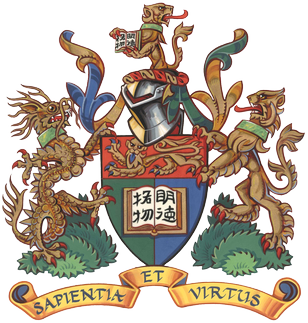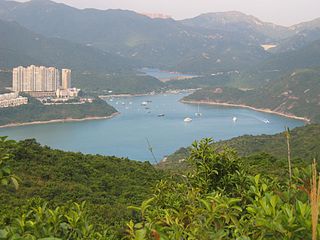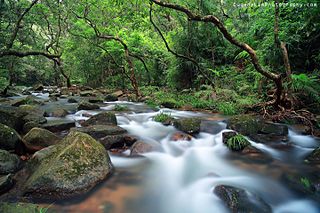
The Southern District is one of the 18 districts of Hong Kong. It is located in the southern part of Hong Kong Island and the largest part of the island. It had a population of 274,994 in 2016.
The ecology of Hong Kong is mostly affected by the results of climatic changes. Hong Kong's climate is seasonal due to alternating wind direction between winter and summer.

The University of Hong Kong (HKU) is a public research university in Pokfulam, Hong Kong. It was founded in 1887 as the Hong Kong College of Medicine for Chinese by the London Missionary Society and formally established as the University of Hong Kong in 1911. It is the oldest tertiary institution in Hong Kong.

Hoi Ha Wan or Jone's Cove is a bay at the north of Sai Kung Peninsula. It is part of Hoi Ha Wan Marine Park, a marine park in Hong Kong. The village of Hoi Ha is located on the innermost shore of Hoi Ha Wan.

Quarry Bay is an area beneath Mount Parker in the Eastern District of Hong Kong Island, in Hong Kong. Quarry Bay is bordered by Sai Wan Ho to the east, Mount Parker to the south, North Point to the west, and Victoria Harbour to the north.
The Shing Mun Country Park is a country park of Hong Kong, hugging the Shing Mun Reservoir.

Green Island is an island off the northwest coast of Kennedy Town, Hong Kong Island, separated by the Sulphur Channel. A smaller island nearby to the east, uninhabited, is called Little Green Island (小青洲). Administratively, the two islands are part of Central and Western District.

Ocean Park Hong Kong, commonly known simply as Ocean Park, is an animal theme park in Hong Kong. Covering an area of 91.5 hectares in Wong Chuk Hang, it is the largest theme park by area in Hong Kong, and is also the city's second oldest theme park, after the now-defunct Lai Chi Kok Amusement Park.

Cape D'Aguilar is a cape on Hong Kong Island, Hong Kong. The cape is on the southeastern end of D'Aguilar Peninsula. To its north are Shek O and D'Aguilar Peak.

The Agriculture, Fisheries and Conservation Department (Chinese: 漁農自然護理署; formerly the Agriculture and Fisheries Department before 2000, of the Hong Kong Government is responsible for agriculture and fisheries in Hong Kong, conservation projects and issues, and managing the country parks and special areas.

Double Haven or Yan Chau Tong is a harbour enclosed by Double Island, Crescent Island and Crooked Island within the north-eastern New Territories of Hong Kong. It is known for its scenery and natural environment, and for the calm seas from which its English name derives. Double Haven contains many deep red coloured rocks because of iron oxide.

Tai Tam Harbour is a harbour in the innermost part of Tai Tam Bay in the southeastern part of Hong Kong Island, in the Southern District of Hong Kong. It is located at the estuary of Tai Tam Tuk.

Shek O Country Park is a rural marine park located on Shek O, Southern District, Hong Kong and facing the South China Sea. The 701-hectare park opened on 21 September 1979.

The Tai Po Kau Nature Reserve, also called Tai Po Kau Special Area, is a nature reserve in the Tai Po area of the New Territories in northern Hong Kong. The area comprises a dense, hilly woodland with over 100 species of trees and numerous streams and rivers. It is one of the most biologically diverse forests in Hong Kong. It is noted by the Hong Kong Bird Watching Society and others as one of the best locations for seeing forest birds in Hong Kong.

Port Shelter, known in Cantonese as Ngau Mei Hoi, is a harbour south of Sai Kung Peninsula in Hong Kong. The water body connects to Inner Port Shelter, as well as Hebe Haven (白沙灣), Rocky Harbour (糧船灣海) and other water body. Outer Port Shelter, is situated at the mouth of the harbour.

D'Aguilar Peninsula is located in southeastern Hong Kong Island, in the Southern District of Hong Kong. It is named after Major-General Sir George Charles d'Aguilar.

Kau Pei Chau is an uninhabited islet located off the coast of Hong Kong Island on its southeastern end, about 50 metres (165 feet) off the tip of Cape D'Aguilar. Administratively, it is part of Southern District. Kau Pei Chau has a length of 1.34 kilometres (0.83 mi). It is located directly south of the Cape D’Aguilar Marine Reserve.

D'Aguilar Peak or Hok Tsui Shan is a hill in southeastern Hong Kong. D'Aguilar Peak is clearly visible from the Dragon's Back trail, although the trail doesn't traverse its summit. It is named after Major-General Sir George Charles d'Aguilar.

Ng Cho-nam, SBS, JP, was a Hong Kong environmental studies scholar and conservationist who taught as an associate professor within the Department of Geography at the University of Hong Kong. He served as a top advisor on numerous Hong Kong government committees in areas of conservation, sustainable development, environmental protection, urban planning, and was an active member in various environmental NGOs. He was the director of the Conservancy Association from 2000 to 2019.

This article highlights the campuses of the University of Hong Kong.



















